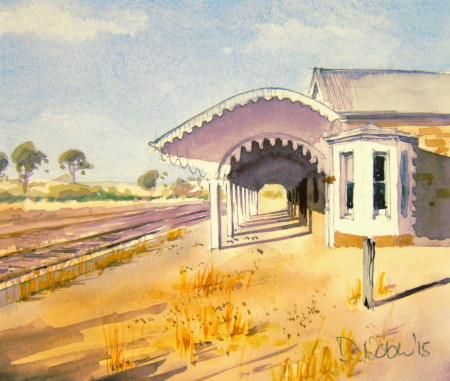
SOLD
SOLD
49 x 59
We’d call it a garage today.
This house hadn’t been lived in for twenty years, we were told, and there were still bits of wind-blown washing on the clothes line left by its last occupants.
The back of the house is on the left, and the limestone structure on the right is an above-ground water tank, common on farms near here.
SOLD
Click on image to view
49 x 59
This humble shelter for its collection of tractors and farm implements is at the base of a giant sand-hill, close to the edge of the River Murray.
The elderly woman owner was mystified, as she tended her vegetable garden, why anyone would want to paint her old shed.
Click on image to view
49 x 59
“Where’s Sandalwood?” you ask.
It’s on the same grain railway as Wynarka and Karoonda, with a population up in the teens, on a good day.
SOLD
Click on image to view
49 x 59
Australian farmers have long taken a pride in using whatever materials are at hand.
This farmer needed shelter for his small grain elevator which hides in the depths of this tiny shed, built entirely of second-hand materials; galvanised iron, only slightly rusty, and old railway sleepers.
Click on image to view
48 x 59
Wynarka’s a tiny settlement on the grain-railway between Tailem Bend and Loxton.
The nearer structure was a lime kiln, built to turn the local limestone into the quicklime that was then mixed with sand in the early days, to make mortar.
The kiln itself was built of the same materials, and among its first products would have been the quicklime for the dis-used shed beyond.
Click on image to view
48 x 59
The same shed as in Shed (1) from a slightly different angle.
The damage wrought by the wind and rain is pretty clear.
Click on image to view
48 x 59
It’s more a loose association of several sheds around an old stone core.
Its various bits were built mostly of second-hand materials as the farmer’s needs arose.
Some parts collapsed, as the winds became too strong for his style of construction.
Click on image to view
SOLD
48 x 53
One day, maybe, someone will restore this old 1920’s warrior.
Meanwhile it sits under rusting galvanised iron behind a farmhouse, waiting for one-day to arrive.
SOLD
Click on image to view